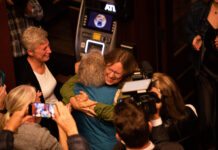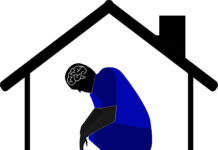How much do you know? How much do you know about your system, your culture, everything came from? How many people do you know with whom you can talk, build a connection that was there centuries ago and feel at home? How much do you know?
This story is about Amy Smoke, who is Mohawk Nation, Turtle Clan from the Six Nations of the Grand River. They are Indigiqueer, two-spirit parent, teacher, and community organizer. They are a founding member of the local First Nations Drum Group and sit on various advisory circles in the region.
Amy attended a local school while growing up in Kitchener, unlike their grandfather who attended the Mohawk Institute Residential School. Growing up among non-Indigenous classmates they experienced bullying and not-so-subtle comments from their peers telling them to “go back to where they came from.”
They were not around any ceremonies or traditions and neither part of any organized religion. They never had a chance to learn about their own identity, their own people, and the feeling of belonging. What followed came in like a storm and swept them through substance abuse, suicidal thoughts and frequently running away from the house they could not call home.
After a couple of years of partying through this feeling, a few days before their 22nd birthday, Amy found themselves in an Indigenous-only healing lodge in Toronto. The drums, the sage, the teachings — they all made sense and came to them naturally. During the four-month live-in program, they felt connected to their culture and heritage for the first time. “I knew that I had come home.”
When Amy first returned to Kitchener, after a series of bad decisions and abusive relationships, they did not seek help from local Indigenous organizations — a decision they now consider to be a big mistake.
Amy had their first daughter at that time and found purpose in raising the little girl, seeking to be the perfect parent.
When they lost their daughter and their house a few years later, they once again became engulfed in the cycle of substance abuse and mistakes. “I did everything I never thought I would growing up, getting in trouble with the law, couch surfing, waking up in crack houses, exploiting not only myself but also other women, everything unimaginable,” they admitted.
Amy was tired of this vicious circle and wanted to build everything from the ground up. Starting from subsidized housing and getting up every day and not wanting drugs, they applied to college.
“I met the most wonderful people and one of the teachers who helped me with getting my funding said that we were in this together, and for the second time I felt like I was home, all because of the generosity of a total stranger,” they said.
“Suddenly, I was talking in classes about being a First Nations student and was on the college’s banners, website, commercials and all marketing materials. What you do here, counts out there.” The acknowledgement of the importance of representation gave Amy the confidence boost they needed to continue.
University was yet another culture shock, because it was so different from the institution they had been at before, where there were students from their own community. Not one to back down from a challenge, they reactivated the Indigenous student association and made the organization’s presence known.
“Two dozen Indigenous students started using our facility regularly, and we feed over a hundred campus communities during our weekly lunches,” they said.
How do we make academic spaces safer for Indigenous people? How do we move from rows of desks to circles where meaningful conversation can occur?
When Amy first started questioning how to make the system more accommodating for Indigenous people, and they were met with rolling eyes. “We learnt so little about anti-oppressive theory, Indigenous knowledge, queer, and feminist theories, like whom did we think we were going to be out there in the world with? With our little degrees in our hands?”
Amy suggests other ways of learning and teaching, such as including laureates and professionals from the Indigenous communities and letting them talk and share their stories.
“Come to our spaces and invite us to yours. We are already healing ourselves and our families and are expected to educate you too about us. Read about us, do your research, and meet us halfway. Make some meaningful connections. Nothing about us without us.”
Amy was often asked to share their story, and talk about colonization, all while they were being colonized at that very moment. The systemic racism and discrimination faced by Indigenous students is not history, it is current and their everyday lived reality.
“I talk so much about myself and my history because I want people to know that when I walk through those doors — the beauty, the pain and the intergenerational trauma and healing, all of it. As a stronger and healthier First Nation[s] person it is my responsibility to bring that sense of belonging and identity to other Indigenous people, and I want them to have the same sense of home which I did when I went through all those experiences of healing.”
This article does not do justice to the millions of emotions, experiences and learning of Amy Smoke, but I am hopeful it gives the reader a sense of what it does to an individual when they are apart from their identity.
This is a story about Amy Smoke. This is a story about finding your home.






























